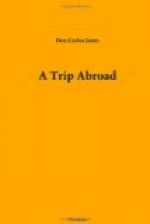to anger than all the kings of Israel that were before
him, * * * did Hiel the Beth-elite build Jericho:
he laid the foundation thereof with the loss of Abiram
his first-born, and set up the gates thereof with
the loss of his youngest son Segub, according to the
word of Jehovah, which he spake by Joshua the son
of Nun” (1 Kings 16:33,34). “The
Jericho * * * which was visited by Jesus occupied a
still different site,” says Bro. McGarvey.
The present Jericho is a small Arab village, poorly
built, with a few exceptions, and having nothing beautiful
in or around it but the large oleanders that grow
in the ground made moist by water from Elisha’s
Fountain. We had satisfactory accommodations at
the hotel, which is one of the few good houses there.
Jericho in the time of our Lord was the home of a
rich publican named Zaccheus (Luke 19:1-10), and was
an important and wealthy city, that had been fortified
by Herod the Great, who constructed splendid palaces
here, and it was here that “this infamous tyrant
died.” The original Jericho, the home of
Rahab the harlot, was called the “city of palm
trees” (Deut. 34:3), but if the modern representative
of that ancient city has any of these trees, they
are few in number. Across the Jordan eastward
are the mountains of Moab, in one of which Moses died
after having delivered his valedictory, as recorded
in Deuteronomy. (Deut. 34:1-12.) From a lofty peak
the Lord showed this great leader and law-giver a
panorama of “all the land of Gilead unto Dan.
* * * And Jehovah said unto him, This is the land which
I sware unto Abraham, unto Isaac, and unto Jacob, saying,
I will give it unto thy seed: I have caused thee
to see it with thine eyes, but thou shalt not go over
thither. So Moses the servant of Jehovah died
there in the land of Moab, according to the word of
Jehovah. And he buried him in the valley in the
land of Moab, over against Beth-peor: but no man
knoweth of his sepulchre unto this day.”
Early Wednesday morning we began our toilsome journey
back to Jerusalem, having nearly four thousand feet
to climb in the twenty miles intervening. We
stopped awhile at the Khan of the Good Samaritan, which
stands near some old ruins, and may not be far from
the place to which the Good Samaritan carried his
poor, wounded fellow-man so long ago. Here I
bought some lamps that look old enough, but may be
quite modern imitations of the kind that were carried
in the days of the wise and foolish virgins.
A stop was also made at the Apostles’ Fountain,
near Bethany, where I saw an Arab working bread on
his coat, which was spread on the ground. Over
by the Damascus gate I one day saw a man feeding his
camel on his coat, so these coarse cloth garments are
very serviceable indeed. We got back to Jerusalem
in time to do a good deal of sight-seeing in the afternoon.




